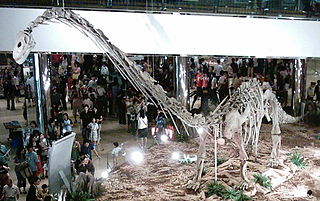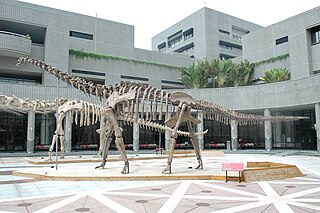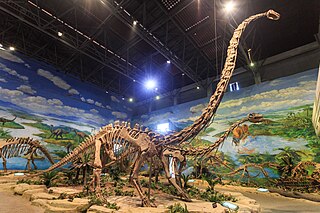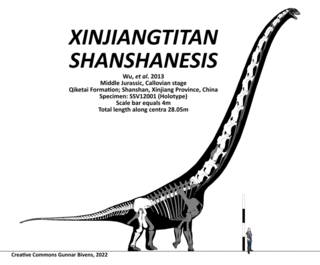
Mamenchisaurus is a genus of sauropod dinosaur known for their remarkably long necks which made up nearly half the total body length. Numerous species have been assigned to the genus; however, the validity of these assignments has been questioned. Fossils have been found in the Sichuan Basin and Yunnan Province in China. Several species from the Upper Shaximiao Formation, whose geologic age is uncertain, have been described. However, evidence suggests this formation to be no earlier than the Oxfordian stage of the Late Jurassic. M. sinocanadorum dates to the Oxfordian stage, and M. anyuensis to the Aptian stage of the Early Cretaceous. Most species were medium-large to large sauropods, measuring roughly 15 to 26 meters in length—possibly up to 35 meters (115 ft), based on two undescribed vertebrae.

Omeisaurus is a genus of sauropod dinosaur from the Middle Jurassic Period of what is now China. Its name comes from Mount Emei, where it was discovered in the lower Shaximiao Formation of Sichuan Province.
Daanosaurus was a genus of dinosaur. It was a sauropod which lived during the Late Jurassic. It lived in what is now China, and was similar to Bellusaurus.

Huanghetitan, is a genus of sauropod dinosaur from the early Cretaceous Period. It was a basal titanosauriform which lived in what is now Gansu, China.
Eomamenchisaurus is a genus of mamenchisaurid sauropod dinosaur from the Middle Jurassic Zhanghe Formation of Yuanmou, Yunnan, China. The type species is E. yuanmouensis, described by Lü Junchang et al. in 2008.

Daxiatitan is a genus of sauropod dinosaur known from the Lower Cretaceous of Gansu, China. Its type and only species is Daxiatitan binglingi. It is known from a single partial skeleton consisting of most of the neck and back vertebrae, two tail vertebrae, a shoulder blade, and a thigh bone. At the time of its discovery in 2008, Daxiatitan was regarded as potentially the largest known dinosaur from China.

Mamenchisauridae is a family of sauropod dinosaurs belonging to Eusauropoda known from the Jurassic and Early Cretaceous of Asia and Africa. Some members of the group reached gigantic sizes, amongst the largest of all sauropods.

The Tiaojishan Formation is a geological formation in Hebei and Liaoning, People's Republic of China, dating to the middle-late Jurassic period. It is known for its exceptionally preserved fossils, including those of plants, insects and vertebrates. It is made up mainly of pyroclastic rock interspersed with basic volcanic and sedimentary rocks. Previously, the Tiaojishan Formation was grouped together with the underlying Haifanggou Formation as a single "Lanqi Formation." The Tiaojishan Formation forms a key part of the Yanliao Biota assemblage, alongside the Haifanggou Formation.
The Haifanggou Formation, also known as the Jiulongshan Formation, is a fossil-bearing rock deposit located near Daohugou village of Ningcheng County, in Inner Mongolia, northeastern China.
Tonganosaurus is a genus of mamenchisaurid sauropod dinosaur, similar to Omeisaurus. It is known from one specimen consisting of twenty vertebrae, a front limb and pectoral girdle, and a complete hind limb with partial hip. It was discovered in the Yimen Formation, China. The horizon of the specimen and the age of the Yimen Formation is controversial. The formation has been divided into three levels, and Tonganosaurus appears to be of late Early Jurassic (Pliensbachian) age. Tonganosaurus is the oldest known member of the mamenchisaurids, being almost 15 million years older than the next-oldest members of the group. It was first named by Li Kui, Yang Chun-Yan, Liu Jian and Wang Zheng-Xin in 2010 and the type species is Tonganosaurus hei.

Xinjiangtitan is an extinct genus of mamenchisaurid sauropod that lived during the Middle Jurassic of what is now Xinjiang, northwestern China. Its type and only species is Xinjiangtitan shanshanesis, known from a single incomplete skeleton recovered from the Qiketai Formation. The holotype preserves one of the most complete vertebral columns of any sauropod found in Asia, and has the longest complete neck known for any animal.

Huangshanlong is a genus of mamenchisaurid dinosaurs native to the Anhui province of China. It contains a single species, Huangshanlong anhuiensis. H. anhuiensis represents, along with Anhuilong and Wannanosaurus, one of three dinosaurs found in Anhui province.
Qijianglong is a genus of herbivorous mamenchisaurid sauropod dinosaur from the Early Cretaceous of China.

Anhuilong is a genus of mamenchisaurid dinosaur known from the Hongqin Formation of Anhui province, China. The genus contains a single species, Anhuilong diboensis.
Fushanosaurus is a genus of sauropod dinosaur from the Shishugou Formation from Xinjiang Province in China. The type and only species is Fushanosaurus qitaiensis. It is solely known from the holotype specimen FH000101, a complete right femur.
Analong is a genus of mamenchisaurid sauropod dinosaur from the Chuanjie Formation in Yunnan, China. The type and only species is Analong chuanjieensis.
Rhomaleopakhus is a genus of mamenchisaurid sauropod, dinosaur from the Late Jurassic Kalaza Formation of China. The type and only species is Rhomaleopakhus turpanensis.

Bashanosaurus is an extinct genus of stegosaurian dinosaur from the Middle Jurassic Shaximiao Formation of Yunyang County, China. The genus contains a single species, Bashanosaurus primitivus, known from incomplete skeletons belonging to three individuals. It is one of the basalmost stegosaurs, as well as one of the oldest known stegosaurs, along with Adratiklit and Isaberrysaura.
Jingia is a genus of moths in the family Noctuidae. The genus was named by Chen in 1983 and the type species is J. vestigialis.
The Dongxing Formation is a geological formation in Guangxi, China. It dates to the Late Jurassic. It is named for Dongxing County in Guangxi. It is made up of quartzitic arkose interbedded with purplish red mudstone. Jingia dongxingensis, a species of sauropod dinosaur, is known from this formation.






















